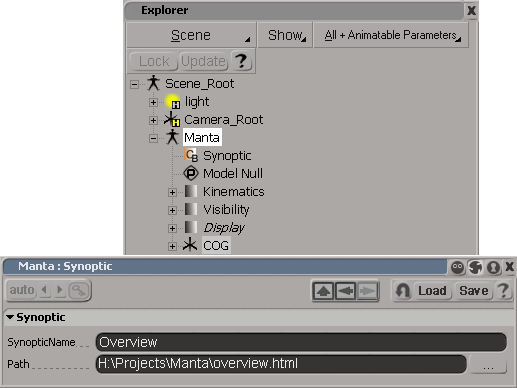A synoptic property associates a scene object with a synoptic file. Once you have applied a synoptic property, you can display it by selecting the object and pressing F3.
You can apply synoptic properties in node or branch mode. Objects can also have multiple synoptic properties — use the up and down arrow keys to cycle through multiple synoptic views.
Synoptic properties are classified as custom properties so, for example, you can redisplay the Synoptic property editor using
Edit  Properties
Properties  Custom Properties.
Custom Properties.
Select an object in node or branch mode. For most purposes, applying a synoptic property in branch mode is better — you can select any descendent and quickly open the synoptic view on its ancestor.
Choose Get  Property
Property  Synoptic from any toolbar. The Synoptic property editor opens.
Synoptic from any toolbar. The Synoptic property editor opens.
Set the parameters as desired:
Synoptic Name is displayed on the title bar of the synoptic view.
Path specifies the synoptic file to display. You can type a location and file name directly in the box, or use the browse button (...) to select a file. You can use a relative path if the synoptic file is saved in your scene, or an absolute path if it is saved in an application data path. You can also use environment variables in the path, for example, $MYHOME/Data/Synoptic/Rig.html.

 Except where otherwise noted, this work is licensed under a Creative Commons Attribution-NonCommercial-ShareAlike 3.0 Unported License
Except where otherwise noted, this work is licensed under a Creative Commons Attribution-NonCommercial-ShareAlike 3.0 Unported License